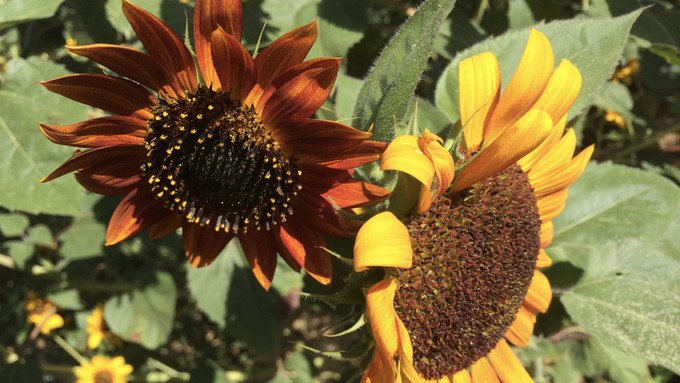
Heat arrives and so does vegetable planting time

It's time to plant sunflowers -- the bees are counting on you! Kathy Morrison
After an unusually cool spring, summer arrived early this weekend with temperatures in the high 90s.
According to the National Weather Service, this welcome warm-up follows several chilly months.
“Today will be a hot day, with many locations in the Valley reaching the upper 90s, but did you know 2023 has been unusually cool so far?” tweeted the NWS Sacramento office on Saturday. “Average temperatures for Downtown Sacramento since January 1st have been the coolest since 2011.”
The month of May averages highs of about 80 degrees in Sacramento. This coming week will be well above that norm with most days in the low 90s and sunny, gradually cooling back into the 80s by next week.
Just as important, overnight lows aren’t that low; they’re on the warm side, too. We’ll stay above 57 degrees every night this week. Average lows for this time of year: 51 degrees.
That night-time warmth will heat soil and get roots growing – and plants sprouting fast.
In other words, it’s summer vegetable planting time. Get those tomatoes – and peppers, eggplant, squash, melons, etc. – in the ground.
Don’t forget to water. Our forecast is not only warm, it’s totally dry. Seedlings need moisture. Deep watering will help build strong roots and healthy plants.
* When setting out tomato seedlings, pinch off any flowers on new transplants to make them concentrate on establishing roots instead of setting premature fruit.
* Direct-seed melons, cucumbers, summer squash, corn, radishes, pumpkins and annual herbs such as basil.
* In the flower garden, direct-seed sunflowers, cosmos, salvia, zinnias, marigolds, celosia and asters. You also can transplant seedlings for many of the same flowers.
* Plant dahlia tubers. Other perennials to set out include verbena, coreopsis, coneflower and astilbe.
* Transplant petunias, marigolds and perennial flowers such as astilbe, columbine, coneflowers, coreopsis, dahlias, rudbeckia and verbena.
* Keep an eye out for slugs, snails, earwigs and aphids that want to dine on tender new growth.
* Feed summer bloomers with a balanced fertilizer.
* For continued bloom, cut off spent flowers on roses as well as other flowering plants.
* Put your veggie garden on a regular diet. Set up a monthly feeding program, and keep track on your calendar. Make sure to water your garden before applying any fertilizer to prevent “burning” your plants.
* As spring-flowering shrubs finish blooming, give them a little pruning to shape them, removing old and dead wood. Lightly trim azaleas, fuchsias and marguerites for bushier plants.
* Run the sprinklers early in the morning – before 8 a.m. if possible – to conserve water and minimize plant diseases.
* Add mulch to the garden to help keep that precious water from evaporating. Mulch also cuts down on weeds. But don’t let it mound around the stems or trunks of trees or shrubs. Leave about a 6-inch to 1-foot circle to avoid crown rot or other problems.
Comments
0 comments have been posted.Sacramento Digs Gardening to your inbox.
Sites We Like
Garden Checklist for week of Nov. 3
November still offers good weather for fall planting:
* If you haven't already, it's time to clean up the remains of summer. Pull faded annuals and vegetables. Prune dead or broken branches from trees.
* Now is the best time to plant most trees and shrubs. This gives them plenty of time for root development before spring growth. They also benefit from fall and winter rains.
* Set out cool-weather annuals such as pansies and snapdragons.
* Lettuce, cabbage and broccoli also can be planted now.
* Plant garlic and onions.
* Keep planting bulbs to spread out your spring bloom. Some possible suggestions: daffodils, crocuses, hyacinths, tulips, anemones and scillas.
* This is also a good time to seed wildflowers and plant such spring bloomers as sweet pea, sweet alyssum and bachelor buttons.
* Rake and compost leaves, but dispose of any diseased plant material. For example, if peach and nectarine trees showed signs of leaf curl this year, clean up under trees and dispose of those leaves instead of composting.
* Save dry stalks and seedpods from poppies and coneflowers for fall bouquets and holiday decorating.
* For holiday blooms indoors, plant paperwhite narcissus bulbs now. Fill a shallow bowl or dish with 2 inches of rocks or pebbles. Place bulbs in the dish with the root end nestled in the rocks. Add water until it just touches the bottom of the bulbs. Place the dish in a sunny window. Add water as needed.
* Give your azaleas, gardenias and camellias a boost with chelated iron.
* For larger blooms, pinch off some camellia buds.
* Prune non-flowering trees and shrubs while dormant.
* To help prevent leaf curl, apply a copper fungicide spray to peach and nectarine trees after they lose their leaves this month. Leaf curl, which shows up in the spring, is caused by a fungus that winters as spores on the limbs and around the tree in fallen leaves. Sprays are most effective now.